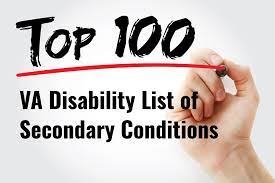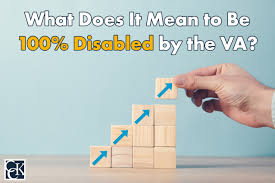The VA Disability List of Secondary Conditions: Understanding Your Benefits
When it comes to receiving disability benefits from the Department of Veterans Affairs (VA), understanding the VA Disability List of Secondary Conditions is crucial. In addition to primary service-connected disabilities, veterans may also be eligible for compensation for secondary conditions that have resulted from their primary disabilities.
A secondary condition is a medical issue that arises as a direct result of a service-connected disability. For example, if a veteran has a primary disability such as a knee injury, they may develop arthritis in that same knee due to the initial injury. In this case, the arthritis would be considered a secondary condition.
To determine if your secondary condition is eligible for compensation, it must meet certain criteria. First and foremost, you must have an already established service-connected disability. The secondary condition must also be directly caused or aggravated by your primary disability or its treatment.
It’s important to note that not all secondary conditions are automatically recognized by the VA. However, there is a list of commonly recognized secondary conditions that can help guide veterans and their healthcare providers when seeking compensation.
The VA Disability List of Secondary Conditions includes various medical issues across different body systems. Some examples include:
- Mental Health: Mental health conditions such as depression, anxiety disorders, and post-traumatic stress disorder (PTSD) can be considered secondary to service-connected physical injuries or combat-related trauma.
- Musculoskeletal System: Conditions like arthritis, joint pain, and limited range of motion can be recognized as secondary to injuries sustained during military service or as a result of chronic pain caused by other service-related disabilities.
- Respiratory System: Chronic respiratory conditions such as asthma or chronic obstructive pulmonary disease (COPD) can be considered secondary to exposure to hazardous substances during military service.
- Cardiovascular System: Heart conditions like hypertension and heart disease may be recognized as secondary if they are caused or aggravated by service-connected disabilities or medication used to treat them.
- Digestive System: Gastrointestinal conditions such as ulcers, irritable bowel syndrome (IBS), and liver disease can be considered secondary if they are caused or worsened by service-connected disabilities or medications.
It’s important to keep in mind that the VA will evaluate each case individually, considering medical evidence and the impact of the secondary condition on your overall health and ability to work. It is advisable to gather all relevant medical records and consult with a healthcare provider who can help establish a nexus between your primary and secondary conditions.
To apply for compensation for a secondary condition, you will need to file a claim with the VA. The claim should include supporting medical evidence, such as doctor’s reports, test results, and treatment records. The VA will review your claim and make a decision based on the evidence provided.
Understanding the VA Disability List of Secondary Conditions is essential for veterans seeking compensation for their service-connected disabilities. By recognizing the potential impact of secondary conditions, veterans can ensure they receive the benefits they deserve for their sacrifices in service to our country. If you have any questions or need assistance with your claim, it is recommended to reach out to a Veterans Service Organization or an accredited representative who can provide guidance throughout the process.
Remember, you are not alone in navigating this complex system. The VA is committed to supporting veterans by providing compensation for both primary and secondary conditions.
Frequently Asked Questions: VA Disability Secondary Conditions and Claims
- How do I file a claim for secondary conditions related to my VA disability?
- What types of secondary conditions are eligible for VA benefits?
- What evidence do I need to provide when filing a claim for secondary conditions?
- Are there any time limits or deadlines associated with filing a claim for secondary conditions?
- How long does it take to receive approval or denial of a claim for secondary conditions?
- What should I do if my claim is denied or approved with reduced benefits due to the presence of secondary conditions?
How do I file a claim for secondary conditions related to my VA disability?
Filing a claim for secondary conditions related to your VA disability requires following a specific process. Here are the steps you can take:
- Gather Medical Evidence: Start by collecting all relevant medical records that support the connection between your primary and secondary conditions. This may include doctor’s reports, test results, treatment records, and any other documentation that demonstrates the link.
- Consult with a Healthcare Provider: It is beneficial to consult with a healthcare provider who can provide an expert opinion and establish a nexus between your primary and secondary conditions. They can help document the medical evidence required to support your claim.
- Complete VA Form 21-526EZ: Obtain and fill out VA Form 21-526EZ, which is the Application for Disability Compensation and Related Compensation Benefits. This form can be completed online through the VA’s eBenefits portal or by submitting a paper application via mail.
- Include Supporting Documents: Along with the completed form, include all supporting documents that validate your claim for secondary conditions. This includes medical records, nexus letters from healthcare providers, and any other relevant evidence you have gathered.
- Submit Your Claim: Once you have completed the necessary forms and gathered all supporting documents, submit your claim to the VA for review. If filing online through eBenefits, follow the instructions provided on the website. If submitting a paper application, make copies of all documents before sending them via certified mail to your nearest VA Regional Office.
- Await Decision and Notification: The VA will review your claim along with the supporting evidence provided. This process may take some time as they assess the connection between your primary and secondary conditions. You will receive written notification regarding their decision once it has been made.
- Seek Assistance if Needed: If you encounter any difficulties during this process or require additional guidance, it is recommended to seek assistance from a Veterans Service Organization (VSO) or an accredited representative who can provide support throughout your claim.
Remember, it is essential to be thorough and provide as much evidence as possible to establish the connection between your primary and secondary conditions. By following these steps and submitting a well-documented claim, you increase your chances of receiving compensation for your secondary conditions related to your VA disability.
What types of secondary conditions are eligible for VA benefits?
The VA recognizes a wide range of secondary conditions as eligible for benefits. While the specific eligibility criteria may vary, here are some common types of secondary conditions that may qualify for VA benefits:
- Mental Health Conditions: Conditions such as depression, anxiety disorders, and PTSD can be considered secondary to service-connected physical injuries or combat-related trauma.
- Musculoskeletal System: Arthritis, joint pain, limited range of motion, and other musculoskeletal conditions can be recognized as secondary to injuries sustained during military service or caused by chronic pain resulting from other service-related disabilities.
- Respiratory System: Chronic respiratory conditions like asthma or COPD may be recognized as secondary if they are caused or aggravated by exposure to hazardous substances during military service.
- Cardiovascular System: Heart conditions such as hypertension and heart disease might qualify if they are caused or worsened by service-connected disabilities or medications used to treat them.
- Digestive System: Gastrointestinal conditions like ulcers, IBS, and liver disease could be considered secondary if they are caused or exacerbated by service-connected disabilities or medications.
- Neurological Conditions: Neurological disorders such as migraines, neuropathy, and seizures may qualify if they are caused or aggravated by primary service-connected disabilities.
- Endocrine Disorders: Hormonal imbalances and endocrine disorders like diabetes mellitus can be recognized as secondary if they result from certain medications used to treat primary service-connected disabilities.
- Skin Conditions: Skin disorders like eczema, dermatitis, and skin cancer might qualify if they are caused or worsened by exposure to hazardous agents during military service.
- Hearing Loss and Tinnitus: Hearing loss and tinnitus (ringing in the ears) can be considered secondary to exposure to loud noises during military service or as a result of head injuries.
It’s important to note that each case is evaluated individually based on medical evidence and the impact of the secondary condition on overall health and ability to work. To determine eligibility, veterans should consult with healthcare providers and gather relevant medical records to establish a nexus between their primary and secondary conditions.
Applying for benefits for secondary conditions requires filing a claim with the VA, including supporting medical evidence. Veterans can seek assistance from Veterans Service Organizations or accredited representatives to navigate the process effectively.
Remember, this list is not exhaustive, and there may be other secondary conditions that qualify for VA benefits. It’s essential to consult with healthcare providers and reach out to the VA for specific guidance related to your situation.
What evidence do I need to provide when filing a claim for secondary conditions?
When filing a claim for secondary conditions with the Department of Veterans Affairs (VA), providing strong and relevant evidence is crucial to support your case. Here are some types of evidence you should consider including:
- Medical Records: Gather all medical records related to your primary and secondary conditions. This includes doctor’s reports, hospital records, test results, and treatment history. These documents should clearly establish the existence of both conditions and their relationship.
- Nexus Statement: A nexus statement is a medical opinion from a healthcare professional that connects your secondary condition to your service-connected disability. This statement should explain how the primary disability directly caused or aggravated the secondary condition. It’s important to consult with a healthcare provider experienced in working with veterans’ claims to obtain a well-documented nexus statement.
- Treatment History: Provide documentation of any treatments or therapies you have undergone for both your primary and secondary conditions. This can include medications prescribed, surgeries performed, physical therapy sessions, or any other relevant treatments received.
- Expert Opinions: In some cases, obtaining an expert opinion from a specialist in the field may strengthen your claim. For example, if you have a respiratory condition as a secondary condition due to exposure during military service, an opinion from a pulmonologist would carry weight.
- Statements from Lay Witnesses: If there are individuals who can attest to the impact of your secondary condition on your daily life and functioning, consider gathering statements from them. These could be family members, friends, or colleagues who have observed the challenges you face due to the secondary condition.
- VA Disability Benefits Questionnaires (DBQs): DBQs are standardized forms that provide specific information about medical conditions and their impact on daily activities and workability. Having completed DBQs for both your primary and secondary conditions can streamline the claims process.
Remember that each case is unique, so it’s essential to provide evidence specific to your situation. It’s advisable to consult with a Veterans Service Organization (VSO) or an accredited representative who can guide you through the process and help ensure you have the necessary evidence for your claim.
Submitting a well-documented claim with strong supporting evidence increases your chances of receiving a favorable decision from the VA. Be thorough, organized, and persistent throughout the process to advocate for the benefits you rightfully deserve.
Are there any time limits or deadlines associated with filing a claim for secondary conditions?
Yes, there are time limits or deadlines associated with filing a claim for secondary conditions with the Department of Veterans Affairs (VA). It is important to be aware of these deadlines to ensure that you do not miss out on potential benefits.
The general rule is that you should file your claim for a secondary condition within one year from the date of your primary service-connected disability being granted. This one-year period is known as the “presumption of service connection.” Filing within this timeframe helps establish a direct link between your primary and secondary conditions.
However, it’s important to note that missing this one-year deadline does not necessarily mean you are ineligible for compensation. You can still file a claim for a secondary condition beyond the one-year mark. In such cases, you will need to provide additional evidence to establish the connection between your primary and secondary conditions.
While there is no strict deadline beyond the one-year mark, it is generally recommended to file your claim as soon as possible. Delaying the filing process may make it more challenging to gather supporting medical evidence and establish a clear nexus between your primary and secondary conditions.
It’s worth mentioning that each case is unique, and exceptions can be made based on individual circumstances. The VA considers factors such as continuous treatment records, medical opinions linking the conditions, and other relevant evidence when evaluating claims filed after the one-year period.
To ensure you meet all necessary deadlines and have the best chance of success in your claim, it is advisable to consult with a Veterans Service Organization (VSO) or an accredited representative. They can provide guidance specific to your situation and help navigate the claims process effectively.
Remember, even if you miss certain deadlines or time limits, it’s always worth exploring your options and filing a claim for any eligible secondary conditions related to your service-connected disabilities.
How long does it take to receive approval or denial of a claim for secondary conditions?
The time it takes to receive a decision on a claim for secondary conditions can vary depending on several factors. The complexity of the case, the availability of medical evidence, and the current workload of the VA are some of the factors that can affect the processing time.
In general, the VA aims to provide a decision within 125 days from the date they receive your completed claim. However, it’s important to note that this is an average processing time and individual cases may take longer or shorter periods.
To help expedite the process, it is crucial to ensure that all necessary supporting documentation and medical evidence are included with your claim. This includes relevant medical records, doctor’s reports, test results, and any other documentation that establishes a connection between your primary and secondary conditions.
If additional information or examinations are required to make a decision on your claim, it may further extend the processing time. In some cases, the VA may also schedule a Compensation & Pension (C&P) examination to evaluate your condition.
To stay informed about the status of your claim, you can track its progress through the VA’s online portal or by contacting their toll-free number. Additionally, you can seek assistance from Veterans Service Organizations (VSOs) or accredited representatives who can provide guidance and support throughout the process.
While waiting for a decision on your claim can be frustrating, it’s important to remain patient and persistent. Remember that you have the right to appeal any unfavorable decisions if you believe they are incorrect or incomplete.
Overall, while there is no definitive timeline for receiving approval or denial of a claim for secondary conditions, providing thorough documentation and staying engaged in communication with the VA can help facilitate a timely resolution.
What should I do if my claim is denied or approved with reduced benefits due to the presence of secondary conditions?
If your claim is denied or approved with reduced benefits due to the presence of secondary conditions, there are several steps you can take to address the situation:
- Review the Decision Letter: Carefully read the decision letter from the VA to understand their reasoning behind the denial or reduction of benefits. Pay close attention to any specific evidence or documentation they mention as lacking or insufficient.
- Gather Additional Evidence: If you believe that the VA’s decision is incorrect, gather any additional evidence that supports your claim. This may include medical records, doctor’s opinions, test results, and statements from witnesses who can attest to the connection between your primary and secondary conditions. It’s crucial to provide compelling evidence that demonstrates a clear nexus between your service-connected disability and the secondary condition.
- Seek Professional Assistance: Consider seeking assistance from a Veterans Service Organization (VSO) or an accredited representative who specializes in VA claims. These professionals have experience navigating the complex VA system and can provide valuable guidance on how to strengthen your case. They can help you gather relevant evidence, complete necessary paperwork, and advocate on your behalf during the appeals process.
- File an Appeal: If you disagree with the VA’s decision, you have the right to appeal it. The appeals process involves submitting a Notice of Disagreement (NOD) within one year of receiving the decision letter. This notifies the VA of your intent to appeal and initiates further review of your claim by a higher-level adjudicator.
- Request a Personal Hearing: During the appeals process, you have the option to request a personal hearing before a Decision Review Officer (DRO). This allows you to present your case directly and provide additional supporting evidence in person or through video conference. A personal hearing can offer an opportunity for clarification and may increase your chances of success.
- Consider Independent Medical Opinions: If there is disagreement between medical professionals regarding your condition’s nexus with service-connected disabilities, you can seek an independent medical opinion. Obtaining an expert opinion from a qualified specialist who supports your claim can strengthen your case.
- Stay Informed and Persistent: Keep track of important deadlines and stay informed about the appeals process. The VA may request additional information or schedule appointments during this time, so it’s essential to respond promptly. Be persistent in pursuing your claim and maintain open communication with your VSO or representative.
Remember, the appeals process can be lengthy, so it’s important to be patient and persistent. It may take time for the VA to review your case thoroughly. By gathering strong evidence, seeking professional assistance, and advocating for yourself, you increase your chances of a favorable outcome during the appeals process.



